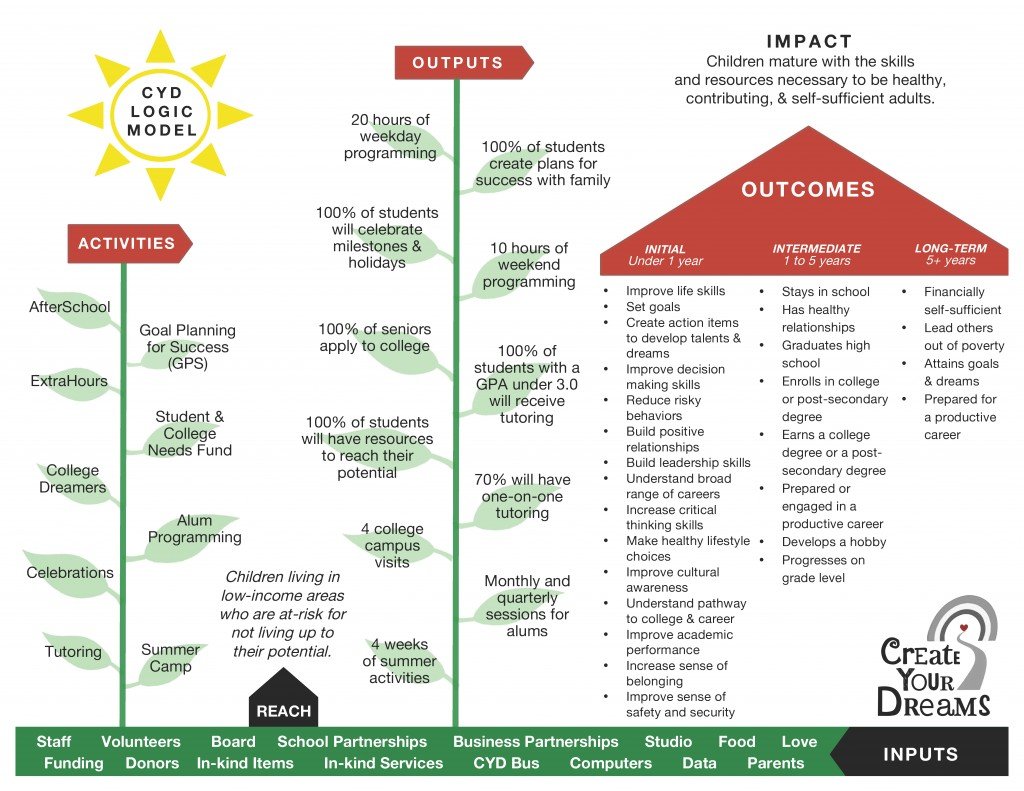Nonprofit logic models and fundraising: What to know

Your nonprofit organization can communicate the impact of your work to donors in various ways. One of these methods is a nonprofit logic model, which is a visual representation of your nonprofit’s resources and how you intend to use them to fulfill your nonprofit’s purpose.
In addition to being more eye-catching than a text-only communication plan, nonprofit logic models allow you to draw connections among three key elements: the resources needed to run your organization’s programs, the organization’s activities, and the long-term goals that your organization aims to achieve.
To demonstrate how your organization can leverage this communication strategy, we’ll walk through the five key components of a logic model and explore an example of an effective model.
While logic models for nonprofit organizations require more analysis to create than other donor communications, there’s no need to panic. Developing a logic model offers an opportunity to build a shared framework of analysis within your organization, articulate the strategy your organization uses to address key issues, and ensure donors at all levels understand how your organization’s work is making a difference.
5 components of a nonprofit organization logic model
Inputs
Inputs are all of the resources you use to successfully run your programs. These can include business partnerships, in-kind contributions, technology, volunteers, and other assets. Connect your inputs to specific activities and their outcomes to assess how your organization leverages its resources.
For each project at your organization, ask yourself questions such as: how many staff members work on the project? What kind of equipment do you use? What revenue sources are backing this initiative? Take into account your funding, external partners, and the amount of time staff and board members will need to dedicate to each project.
Activities
How your nonprofit organization uses inputs are activities. Activities consist of your nonprofit’s various programs, whether they’re initiatives to clean up local beaches, help former incarcerated individuals with reintegration, offer resources for the homeless, or provide a free after-school program.
Outputs
Outputs quantify your activities by looking at the number of people they reached and what that outreach entailed. For example, you would consider 100 people taking part in one of your programs as an output. You’d also take into account how many trips to important locations were made and the number of hours spent helping your constituents.
For each output to be useful, ensure that it has a measurement attached to it, whether it’s people helped, time spent, or visits made.
Outcomes
Outcomes look at what changed for your constituents because they experienced or participated in your program activities. These outcomes can be broken up into three categories:
- Short-term outcomes. Any immediate results from your activities are short-term outcomes. This might include helping individuals improve their life skills after attending your first class or providing immediate mental health care resources.
- Mid-term outcomes. Your activities will likely have several outcomes that can’t clearly be defined as short- or long-term. This could include participants from one of your programs spreading the word about your nonprofit to their friends and family. While spreading awareness to the initial participants would be a short-term outcome and becoming well-established in your community would be a long-term outcome, this middle step is appropriately a mid-term outcome.
- Long-term outcomes. These are the end results of your activities. Examples could include seeing previously homeless members of your community housed and financially secure, reducing your community’s carbon footprint by a specific percentage, or teaching community members skills they will now have for the rest of their lives.
To identify your nonprofit’s outcomes, ask yourself what activities caused participants to change their outlook or behaviors. Consider how specific activities accomplished this by using your inputs to ensure supporters can easily follow your logic model.
Impact
Impact is the overarching change your nonprofit creates in organizations, communities, or systems. To differentiate impact from outcomes, think of your impact as the sum total of all of your outcomes.
For example, by providing educational resources to a school in an underserved community, a nonprofit would have the outcome of helping improve education in their community. They would then have the impact of helping educate the next generation, boosting graduate rates, and instilling a love for learning in local students.
Sometimes, it can be difficult to assess impact for organizations focused on activities providing important, intrinsic value even if there are few measurable long-term outcomes. For example, a homeless services organization that provides regular meals for locals may only play a minor role in helping their beneficiaries escape homelessness. However, the activity of providing a hot, nutritious meal will likely be deeply comforting for the people who receive one.
If this describes how your organization views its work, take the time to flesh out the full vision of the change you’re working towards. This can lead to greater buy-in with your team and help staff make strategic decisions. Involving your colleagues in the process and sharing the results with your entire organization can put tasks and projects in the context of the bigger picture and help you focus your programs.
Nonprofit logic model example
After having walked through the various aspects of a nonprofit logic model, let’s look at an example from Create Your Dreams, a long-term youth development program in Atlanta:

In this logic model, the nonprofit helps donors visualize how their inputs are the seeds that grow into activities and outcomes. The model also directly describes who their target beneficiaries are, which can be especially helpful for nonprofit organizations whose beneficiaries may not be immediately obvious to supporters. Additionally, this logic model provides a strong representation of how short-, mid-, and long-term outcomes all contribute to the greater impact.
Start constructing an effective logic model
Clearly communicating to your donors what resources your nonprofit organization has and how you put them into action to achieve your goals helps them understand your process and feel reassured you’re putting their support to good use. Take an analytical look at your nonprofit’s programs to start constructing an attractive, useful, and shareable logic model.
Ready to Get Started?
Work with Bonterra



